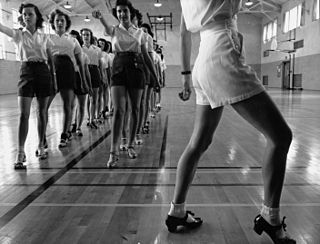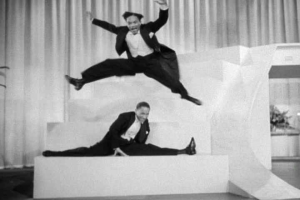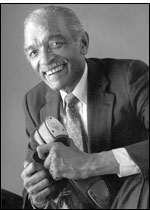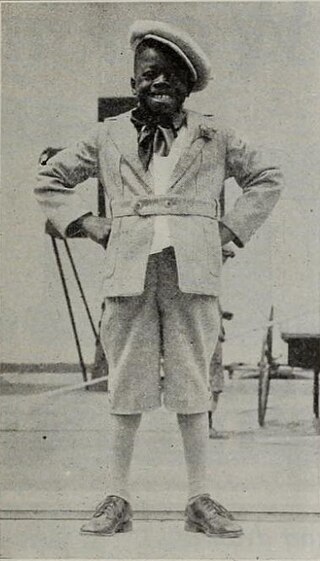
Tap dance is a form of dance that uses the sounds of tap shoes striking the floor as a form of percussion; it is often accompanied by music. Tap dancing can also be a cappella, with no musical accompaniment; the sound of the taps is its own music.

The Cotton Club was a 20th-century nightclub in New York City. It was located on 142nd Street and Lenox Avenue from 1923 to 1936, then briefly in the midtown Theater District until 1940. The club operated during the United States' era of Prohibition and Jim Crow era racial segregation. Black people initially could not patronize the Cotton Club, but the venue featured many of the most popular black entertainers of the era, including musicians Fletcher Henderson, Duke Ellington, Jimmie Lunceford, Chick Webb, Louis Armstrong, Count Basie, Fats Waller, Willie Bryant; vocalists Adelaide Hall, Ethel Waters, Cab Calloway, Bessie Smith, Lillie Delk Christian, Aida Ward, Avon Long, the Dandridge Sisters, the Will Vodery choir, The Mills Brothers, Nina Mae McKinney, Billie Holiday, Midge Williams, Lena Horne, and dancers such as Katherine Dunham, Bill Robinson, The Nicholas Brothers, Charles 'Honi' Coles, Leonard Reed, Stepin Fetchit, the Berry Brothers, The Four Step Brothers, Jeni Le Gon and Earl Snakehips Tucker.

Panama Hattie is a 1940 American musical with music and lyrics by Cole Porter and book by Herbert Fields and B. G. DeSylva. The musical is about a nightclub owner, Hattie Maloney, who lives in the Panama Canal Zone and ends up dealing with both romantic and military intrigue. The title is a play on words, referring to the popular Panama hat.

The Nicholas Brothers were an entertainment act composed of brothers, Fayard (1914–2006) and Harold (1921–2000), who excelled in a variety of dance techniques, primarily between the 1930s and 1950s. Best known for their unique interpretation of a highly acrobatic technique known as "flash dancing", they were also considered by many to be the greatest tap dancers of their day, if not all time. Their virtuoso performance in the musical number "Jumpin' Jive" featured in the 1943 movie Stormy Weather has been praised as one of the greatest dance routines ever captured on film.

Harold Lloyd Nicholas was an American dancer specializing in tap. Nicholas was the younger half of the tap-dancing pair the Nicholas Brothers, known as two of the world's greatest dancers. His older brother was Fayard Nicholas. Nicholas was featured in such musicals as An All-Colored Vaudeville Show (1935), Stormy Weather (1943), The Pirate (1948), and The Five Heartbeats (1991).
Theatre Owners Booking Association, or T.O.B.A., was the vaudeville circuit for African American performers in the 1920s. The theaters mostly had white owners, though about a third of them had Black owners, including the recently restored Morton Theater in Athens, Georgia, originally operated by "Pinky" Monroe Morton, and Douglass Theatre in Macon, Georgia owned and operated by Charles Henry Douglass. Theater owners booked jazz and blues musicians and singers, comedians, and other performers, including the classically trained, such as operatic soprano Sissieretta Jones, known as "The Black Patti", for black audiences.

Valaida Snow was an American jazz musician and entertainer who performed internationally. She was also known as "Little Louis" and "Queen of the Trumpet," a nickname given to her by W. C. Handy.

Charles "Honi" Coles was an American actor and tap dancer, who was inducted posthumously into the American Tap Dance Hall of Fame in 2003. He had a distinctive personal style that required technical precision, high-speed tapping, and a close-to-the-floor style where "the legs and feet did the work". Coles was also half of the professional tap dancing duo Coles and Atkins, whose specialty was performing with elegant style through various tap steps such as "swing dance", "over the top", "bebop", "buck and wing", and "slow drag".
The Four Step Brothers were an African-American dance group. The group started out as a trio in 1925, with the original members, Maceo Anderson, Al Williams and Red Walker. Although their original name was the Step Brothers, because that was also the name of another famous young tap dancing quartet, they subsequently changed their name to "The Three Step Brothers." In 1927, after accepting a new member, Sherman Robinson, they became The Four Step Brothers. Dubbed "The Eight Feet of Rhythm," the group soon traveled with Duke Ellington. While starring with the "Brothers," Anderson also appeared at the Hoofers Club and worked part-time as a newsboy.
Willie Eugene Bailey, known professionally as Bill Bailey, was an American tap dancer. The older brother of actress and singer Pearl Bailey, Bill was considered to be one of the best rhythm dancers of his time and was the first person to be recorded doing the Moonwalk, although he referred to it as the "Backslide," in the film Cabin in the Sky (1943), starring Ethel Waters, Eddie "Rochester" Anderson and Lena Horne.

Nii-lante Augustus Kwamlah Quaye, known professionally as Cab Kaye, was an English jazz singer and pianist of Ghanaian descent. He combined blues, stride piano, and scat with his Ghanaian heritage.
Lillian Goodner was an American blues singer who performed in the classic female blues style popular during the 1920s. She was billed as "Sister Lillian: Queen of the Sepias".

Jeni LeGon, also credited as Jeni Le Gon, was an American dancer, dance instructor, and actress. She was one of the first African-American women to establish a solo career in tap dance.
Jimmy Mordecai also known as James Mordecai was an American, Harlem-based jazz tap dancer in the 1920s and 1930s. He featured in the 1929 short film St. Louis Blues, and starred in the 1930 Vitaphone Varieties musical short film, Yarmekraw, based on James P. Johnson's song of the same name.
Harold J. Cromer was a vaudevillian, Master of Ceremony, Hoofer, Choreographer, and Comedian. He was known as Stumpy in the dance/comedy/acting duo Stump and Stumpy.

Panama Hattie is a 1942 American film based upon the Broadway musical of the same name. It was produced by Arthur Freed and directed by Norman Z. McLeod.
Tip, Tap, and Toe were a seminal African-American tap-dance comedy act that began in the late 1920s and appeared in several motion pictures in the 1930s and '40s. Its original members were Sammy Green, Teddy Frazier, and Raymond Winfield. At times it included Freddie James and Prince Spencer, also a member of The Four Step Brothers. They worked for Eddie Cantor at Palace Theatre in New York and performed on their own at the Paramount Theatre, and were in George White's Scandals of 1936 and the Cotton Club Review. African-Americans were not allowed to star in major motion pictures in the 1930s and '40s, but specialty acts, such as Tip, Tap, and Toe, were permitted, and the group appeared in at least five major Hollywood films during that time.

Miller Brothers and Lois, a renowned tap dance class act team, comprising Danny Miller, George Miller and Lois Bright, was a peak of platform dancing with the tall and graceful Lois said to distinguish the trio. The group performed the majority of their act on platforms of various heights, with the initial platform spelling out M-I-L-L-E-R. They performed over-the-tops, barrel turns and wings on six-foot-high pedestals. They toured theatres coast to coast with Jimmy Lunceford and his Orchestra, Cab Calloway and his Orchestra, and the Count Basie Band.

James Gerald Berry, also known as Bubbles, was an American actor and dancer. He featured in several silent films as a child, and starred in the Berry Brothers dance duo alongside his brothers.
James "Buster" Brown (1913-2002) was an American tap dancer active from the 1930's to 2000. Brown started his career in African-American dance circuits while still in high school and went on to perform internationally, accompanying acts like Duke Ellington and dancing with Savion Glover. Having appeared in numerous films and documentaries, including Francis Ford Coppola's The Cotton Club, he has been described as an inventor of the tap dance art form and one of the most prominent figures in the world of tap dance.